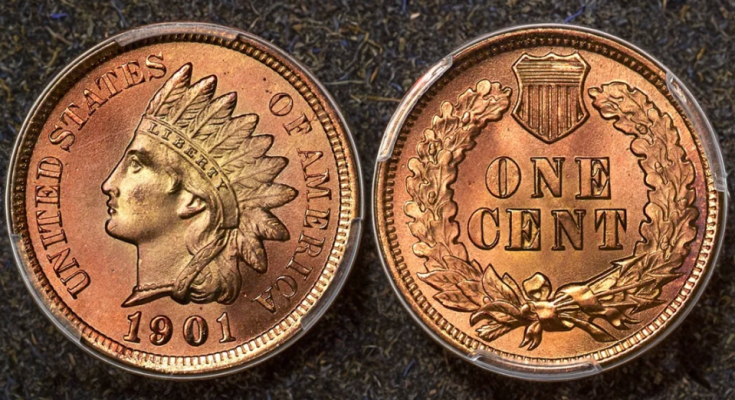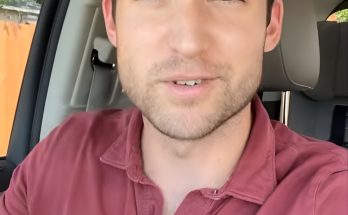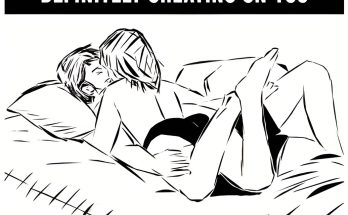The 1901 Indian Head Cent was struck at the brand-new United States Mint facility at 1700 Spring Garden Street in Philadelphia. This new facility, which opened in October, afforded the Mint a much larger production capacity through massive equipment upgrades. Most importantly, all aspects of the production line would now be powered by electricity instead of steam. Additionally, the Mint installed new gas-powered annealing and rolling machines.
This increase in capacity was much needed since the U.S. had recovered from the Panic of 1893, which had forced the Mint to reduce the mintages of cents dramatically several years prior. Yet now the economy was healthy, and there was an ever-increasing demand for cent coins. This demand was fueled mainly by the proliferation of coin-operated machines. America received its first coin-operated vending machines from the Thomas Adams Gum Company in 1888. While today it would seem strange, these early machines accepted one-cent coins – though a penny in 1901 had the same purchasing power as 35 modern cents.
Despite this dramatic increase in demand, production of the one-cent coin was still limited to the Mint facility in Philadelphia. It wouldn’t be until 1906 that this restriction was removed. All of these coins were needed by the economy, and the 1901 Indian Head Cent represented the largest mintage of any coin by the U.S. Mint to that date.
How Much Is the 1901 Indian Head Cent Worth?
Like all modern(ish) copper coins, pieces vary greatly in value due to their color designation and eye appeal.

While the 1901 Indian Head Cent is readily available in Mint State Red, the typical piece found by non-collectors will be in well-worn circulated condition. In these lower grades, $1 to $3 is typical. Circulated coins with more detail, such as an example in Very Fine to Extra Fine, will realize prices between $10 and $15 in eBay auctions and may sell for a little bit more at a retail coin shop. Examples with just a slight bit of wear sell for between $25 and $30.
Mint State 1901 Indian Head Cents typically sell as certified coins, and the market prefers coins graded by CAC, NGC, and PCGS.
Examples in MS63 are relatively similarly priced regardless of color designation, with BN pieces worth $60 to $100, RBs between $80 and $100, and RDs $100 to $150. In MS62, RD examples sell for $60 to $80, $50 to $70 in RB, and $35 to $60 in BN.
At MS64, the price begins to climb. RD and RB examples are worth $200 to $300, and BN examples sell for $100 to $150.
In MS65, while BN examples are worth between $150 and $200, the RB designation provides a small bump to between $200 and $240, and RD provides a large increase of 150% to 200%, pushing the value to approximately $500 to $600. Here, as in MS64, collectors prefer coins in full Red.
MS66RD and MS67RD examples sell for significant premiums. They are suitable grades for Registry Set participants willing to spend tens of thousands of dollars building either a United States Coin Type Set or a complete set of Gem Indian Head Cents. MS66RD coins sell for over a thousand dollars, and recent auction data shows a rather sizable range of prices for coins graded MS67RD (see our “Market Data and Noteworthy Specimens” table below).
Market Data and Noteworthy Specimens
Top Population: PCGS MS67+RD (2, 12/2024), NGC MS67+RD (1, 12/2024), and CAC MS67RD (5:0 stickered:graded, 12/2024).
- PCGS MS67+RD #38999794: Legend Rare Coin Auctions, December 3, 2020, Lot 32 – $30,550; “The Bender Family Collection, Part II,” Heritage Auctions, January 11, 2023, Lot 3327 – $21,600. Bender Collection on insert. Copper spot over 0. Small cluster of copper spots to the left of O of OF. Tiny tick between U and the neck.
- PCGS MS67+RD #38478264: As PCGS MS67RD #25793428. Heritage Auctions, August 10, 2016, Lot 3964 – $9,987.50; “The Castle Collection,” Heritage Auctions, August 14, 2019, Lot 3098 – $9,600. As PCGS MS67+RD #38478264. Heritage Auctions, January 21, 2021, Lot 3994 – $33,600. Upgraded by one-half point. Carbon spot over second 1.
- PCGS MS67RD #42213776: Heritage Auctions, August 20, 2021, Lot 3612 – $5,160; GreatCollections, February 25, 2024, Lot 1471039 – $4,612.50. Spot in the left field under I of UNITED. Carbon spot on the between the second and third diamond. On the reverse, there are carbon spots to the right of the left side of the wreath, the right of T, and at the denticles between 1 and 2 o’clock.
- PCGS MS67RD #35109466: Legend Rare Coin Auctions, May 17, 2018, Lot 320 – $5,287.50; “The Castle Collection,” Heritage Auctions, August 14, 2019, Lot 3097 – $6,300; Heritage Auctions, August 29, 2021, Lot 93171 – $4,800; Heritage Auctions, January 10, 2024, Lot 3146 – $3,720. Reverse dentilation is quite weak.
- PCGS MS67RD EEPS #9949409: “The Stewart Blay Collection of Indian Cents,” GreatCollections, November 19, 2023, Lot 1455984 – $25,875. Copper spot between D and S. Tiny spot under A of STATES. On the reverse, there is a spot under the wreath and another in the field just right of the left side of the wreath. Denticles weak at 1 o’clock. There is a thin scratch on the N of CENT.
- PCGS MS67RD CAC #42656208: As PCGS MS67RD #83220752. Legend Rare Coin Auctions, December 12, 2019, Lot 92 – $4,817.50; As PCGS MS67RD CAC #42656208. GreatCollections, May 15, 2022, Lot 977897 – View; Legend Rare Coin Auctions, September 8, 2022, Lot 8 – $9,106.25. Green and magenta highlights. Carbon spot some distance to the left of the first 1.
- PCGS MS67RD CAC #25671447: Legend Rare Coin Auctions, December 17, 2015, Lot 21 – $15,275; “The Boulder City Collection,” Heritage Auctions, May 23, 2022, Lot 44082 – $8,100.
- PCGS MS67RD #35931916: Stack’s Bowers, October 24, 2018, Lot 242 – $10,200; “The Silver Springs Collection,” Stack’s Bowers, August 16, 2021, Lot 1203 – $5,160.
- PCGS MS67RD #42850565: As PCGS MS67RD #37908212. Heritage Auctions, September 5, 2019, Lot 3319 – $5,760; Stack’s Bowers, August 7, 2020, Lot 2359 – $3,720. As PCGS MS67RD #42850565. GreatCollections, November 7, 2021, Lot 1063076 – View. As PCGS MS67RD #45485294. GreatCollections, August 28, 2022, Lot 1083353 – View. This coin has been recertified three times since 2019! Carbon spot to the right of the second S of STATES. Diagonal scratch to the left of the bust truncation.
- NGC MS67RD #570075-001: “The Estate of Robert R. Rollins Collection, Part I,” Heritage Auctions, May 29, 2008, Lot 2324 – $4,887.50; “The Five Point Collection,” Heritage Auctions, January 6, 2010, Lot 234 – $4,312.50. Carbon spot over first S of STATES. A small cluster of spots above the headdress.
Design
Obverse:
The Indian Head Cent was designed by James B. Longacre, who is perhaps best known for this coin. Longacre was skilled as both a portraitist and engraver, and he was serving as the fourth Chief Engraver of the United States Mint when he designed the coin, first issued in 1859. Despite appearances, the Native American on the obverse is actually an effigy of Lady Liberty, albeit with a supposedly native headdress. Numismatic lore suggests that Longacre based the design on a sketch of his 12-year-old daughter. By most accounts, however – including those of Longacre himself – the model was none other than the Crouching Venus, a Greco-Roman statue on loan from the Vatican that was on display at the Philadelphia Museum of Art in the late 1850s.
The obverse of the Indian Head Cent shows a leftward-facing bust of Miss Liberty adorned in a feathered headdress representative of Native American culture. The headdress includes ornate ribbons, including a large ribbon at the base of the headdress below the feathers over Liberty’s forehead that is inscribed with the word LIBERTY. A smaller ribbon drapes down the back of Miss Liberty’s neck and is laced with a diamond pattern. Another segment of ribbon located deeper in Liberty’s lower hair detail gained more numismatic significance in 1864, when it received the initial “L” for Longacre. The legend UNITED STATES OF AMERICA is inscribed in the field along the obverse rim, and the date 1901 sits at the bottom center of the obverse directly under Liberty’s neck.
Reverse:
The reverse of the 1901 Indian Head Cent features an oak wreath with a Union shield at the top center of the field. The wreath encircles the denomination ONE CENT, which is expressed in two lines of text at the center of the reverse. Since this coin was struck in Philadelphia, there is no mintmark.
Edge:
The edge of the 1901 Indian Head Cent is plain or smooth, without reeding or inscription.
Designer
James Barton Longacre (1794-1869) was one of the most famous U.S. engravers and medallic artists of the 19th century. Longacre was appointed the fourth Chief Engraver of the United States Mint by President John Tyler after Christian Gobrecht died in 1844. Before this appointment, Longacre worked for the Philadelphia engraving company Murray, Draper, Fairman & Co. until he began working for himself in 1819. As an independent engraver, Longacre produced a series of famous plates that featured the Founding Fathers, President Andrew Jackson, and Senator John C. Calhoun. Once he became chief engraver at the Mint, he produced such famous pieces as the Flying Eagle Cent, the Shield Nickel, and the Coronet Head Double Eagle.
Coin Specifications
| Country: | United States of America |
| Year of Issue: | 1901 |
| Denomination: | One Cent (USD) |
| Mintmark: | None (Philadelphia) |
| Mintage: | 79,609,158 |
| Alloy: | .950 copper, .050 zinc and tin |
| Weight: | 3.11 g |
| Diameter: | 19.00 mm |
| OBV Designer: | James Barton Longacre |
| REV Designer: | James Barton Longacre |
| Quality: | Business Strike |



